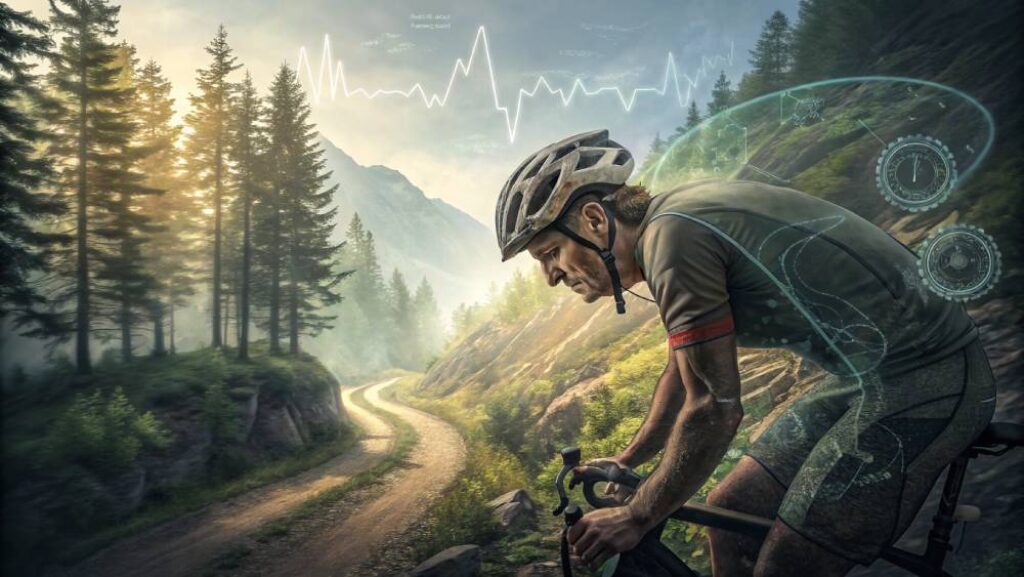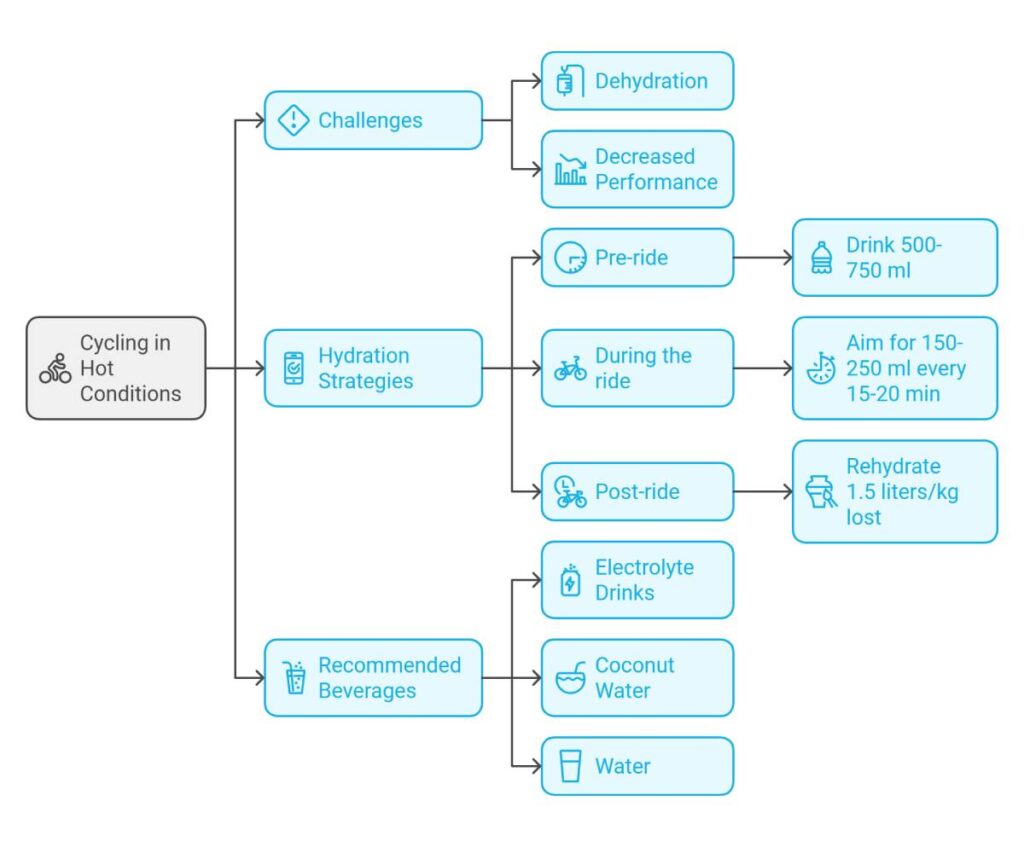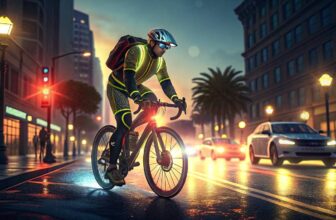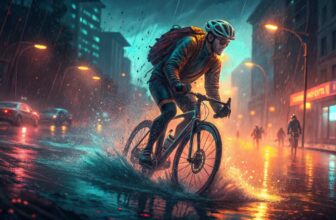Ever hit the trail or road only to feel your energy drain faster than your bike’s chain slipping? Imagine powering through every mile with the same vigor as your first ride.
Welcome to our Expert Cycling Hydration Guide, where we unveil the secrets to staying perfectly fueled and hydrated. Whether you’re a weekend warrior or a seasoned pro, mastering hydration can transform your cycling experience from sluggish to sensational.
Let’s dive into how the right fluids can keep your performance soaring and your rides enjoyable.
Importance of Hydration in Cycling
Keeping yourself well-hydrated is a game-changer for cyclists, both for performing like a champ and staying healthy. It’s like oil for a well-tuned engine—it keeps everything running smoothly and really cranks up your cycling mojo.
Impact of Dehydration on Cycling Performance
Not drinking enough water is bound to throw you off your stride (or should I say pedal?). Even being just a little bit dehydrated can make your brain fuzzy—like you’re cycling through a fog. This brain fog means bad decisions, sluggish reactions, and your overall performance takes a nosedive.

Some common signs you’re running low on H2O while cycling include:
- The heart is doing a sprint while you’re supposed to be cruising
- Feeling woozy or spinning
- The brain feels like it’s stuck in a vice
- Skin’s as dry as the Sahara
- Pungent pee in strange hues
Shedding just 2% of your body weight through sweat transforms you from a pro into an also-ran (1.6 kg gone for someone weighing in at 80 kg):
| Dehydration Level | Effect on Your Game |
|---|---|
| 2% | Can’t help but feel something’s off |
| 4% | Strength gives out halfway through |
| 5% | Your body hits the brakes, work capacity drops like a rock |
| 7% | Get-ready-for-a-funky-freaky-ride, hallucinations kick in |
| 10% | Red alert: possible heat stroke and serious health risks |
Most cyclists find themselves a liter down every hour. Aim to drink enough to fill back at least 75% of that tank.
The Role of Fluid Balance and Electrolytes
Balancing your fluids and electrolytes is like having the perfect DJ mix—nothing too flat, keeping the energy levels high. Keeping hydrated during a ride is a combo of quenching your thirst and dancing with the right electrolytes.
Say hello to the big three electrolytes—think of them as your backstage crew:
- Sodium: Keeps your water bottle from spilling and makes sure your nerves don’t go haywire.
- Potassium: Keeps your muscles in groove mode and balances out the electrolytes like a sound tech.
- Magnesium: Essential for muscle flexing and keeping your energy beats pumping.
Get these in order, and you’ll sidestep cramps, fatigue, and all those other funky dehydration symptoms.
Riders should be in tune with their water and electrolyte needs, adjusting based on the ride vibes. For more jam-packed strategies, check out our hydration tips for different ride lengths.
By tuning into your water needs and keeping that perfect fluid and electrolyte harmony, cyclists unlock peak performance, steering clear of the not-so-cool effects of dehydration. For a few more handy hydration hacks, swing by our bike gear guide.
“Balancing fluids and electrolytes is crucial for maintaining peak performance and preventing cramps during intense rides,” says Alex Mitchell, Professional Cyclist.
Signs and Symptoms of Dehydration
Wanna keep pedaling without keeling over? Pay attention to your body’s warning signs of dehydration while cycling. Spotting them early can help you stay in the saddle longer and healthier.
Recognizing Dehydration During Cycling
Knowing the tell-tale signs of dehydration while you’re pedaling away is your ticket to sidestepping a serious dip in performance and nasty health surprises. Watch out for these red flags:
- Quick heartbeat
- Feeling woozy or dizzy
- Head pounding
- Parched skin
- Pee that looks and smells different
Don’t rely solely on being thirsty to clue you in; your body only nags you for a drink when dehydration’s already knocking at your door, which isn’t great for your biking prowess.
| Symptom | What It’s Telling You |
|---|---|
| Quick Heartbeat | Your heart’s speeding up ’cause there’s less blood to pump around |
| Wooziness or Dizziness | The world’s spinning, and you might hit the deck |
| Head Pounding | Feels like a tiny drummer is inside your skull |
| Parched Skin | Your skin’s dried out like a desert |
| Odd-Looking Pee | It’s darker and whiffier ’cause it’s packed with more stuff your body’s trying to chuck |
Understanding the Effects of Dehydration
Drying up on your ride messes with you more than you might think. Losing even a little water can make you fuzzier up top. It hits your biking game by chopping your stamina, zapping your energy, and messing with how well you can stay upright.
Let it go too far, and things get dicey:
- Brain fogging
- Stamina nosediving
- Balance acting up
- Feeling exhausted
- Heat-related health troubles lurking
Sweat like a fountain or not, everyone has different needs based on sweat, weather, and how hard you’re pushing it. Keep an eye on these factors to dodge the dehydration pitfalls.
For more crafty tips on keeping the waterworks flowing, check our cycling hydration guide.
Hydration Needs Based on Conditions
Mother Nature likes to shake things up — steamy or sticky weather cranks your sweat into overdrive, so it’s essential to up your water game accordingly.
Personalized Hydration Requirements
The hydration script isn’t one-size-fits-all. Every cyclist’s different, and what’s good for one might leave another high and dry. Dialing in how much to drink based on your body’s quirks and your pedal power keeps you at the peak of your game.
Tips for Safely Straightening Curly Hair
Check out our tips for straightening curly hair ’cause keeping those locks safe during exercise isn’t just about looking good but staying hydrated too!
“Understanding how different weather conditions affect your hydration can make the difference between a great ride and a grueling struggle,” notes Jamie Lee, Sports Nutritionist.
Strategies for Proper Hydration
Staying hydrated while pedaling away not only keeps you in the game but also keeps you from feeling like a crumpled mess on the side of the road. Here are some straightforward ways to keep your thirst under control.
Hydration Needs Based on Conditions
You know that feeling when you’re sweating buckets under the sun? That’s when dehydration sneaks up. It gobbles up your energy and leaves you feeling weak as a kitten on your bike. Here’s a cheat sheet for different weather:
| Weather | What to Do |
|---|---|
| Hot & Sweaty | Guzzle down water and sprinkle in some electrolyte magic. |
| Cool & Breezy | Sips of water keep ya fresh. |
| Long Hauls | Mix it up! Water and sports drinks are your best pals. |
Adjust for Mother Nature’s moods. If it’s roasting, you’ll need to drink up more often and grab those electrolytes, ’cause you’re sweating away the good stuff.

Personalized Hydration Requirements
Let’s get personal. Your body does its own funky dance, so your hydration needs might do the cha-cha while someone else’s does the waltz. As a rough guide, aim to chug a bottle of water every hour when cruising on your bike.
To nail your hydration needs:
- Sweat Check: Step on the scale before and after your ride. If you’re lighter, you lose water weight.
- Fitness Freaks: Being more fit might mean you sweat less since your cool-down system’s on point.
- Foodie Alert: Munching on juicy foods? They count towards hydration too.
Keep tabs on your water intake, aiming for about 2-3 liters a day, because your body needs its aqua fix even when you’re not on wheels.
Hydration Tips for Different Ride Lengths
What you drink depends on how long you’re hitting the pavement. Here’s a quick guide:
Short Spins (Under an Hour):
- Water will cover you.
- Take some sips every 15 minutes to stay sharp.
Not-So-Short Rides (1-2 Hours):
- Blend water with electrolyte tablets—avoids the bloat and keeps you fueled.
- Two bottles: one plain, one mixed potion.
Mega Journeys (Over 2 Hours):
- Sports drinks add a kick of electrolytes and a sprinkle of carbs.
- Sip regularly every 10-15 minutes.
- Hydration packs can be your new BFFs for easy slurping.
Remember, drinking up is just one part of the cycling game. For more juicy bits of gear to make your ride slicker than ever, check out our guides on bike lights, cycling shorts, and fancy bike computers. You’ll be the king or queen of the trails in no time!
Best Practices for Hydration During Cycling
Staying hydrated is key to keeping your pedal power strong and sidestepping the dreaded dehydration during rides. Nailing the when, how, and what of cycling hydration can rev up your cycling game.
Hydration Frequency and Timing
Keeping an eye on when and how often you sip water helps keep your fluids in check and pushes dehydration out of the picture. Pedal pushers should sip consistently rather than gulping only when parched. It’s commonly suggested to take small sips every 15-20 minutes as you ride.
| Ride Length | Suggested Hydration Frequency |
|---|---|
| Up to 1 hour | A few sips every 15-20 minutes |
| 1-3 hours | 500-750 ml each hour |
| 3+ hours | 750-1000 ml an hour, bring on those electrolytes |
Sweat rates jump around due to things like the weather, how hard you’re riding, and your own body quirks. When the sun’s got it sizzling, up your intake to match the sweat downpour. Check the pee color before hopping on your bike—you want a pale yellow shade as the green light for good hydration.
Longer, sweatier rides need a drink fix of both fluids and carbs. Aim to get 0.5-1 grams of carbs for every kilo of you per hour. Spread this over a few small grub stops every 20-30 minutes for best results. A 500 ml sports drink mixed at 6% will hook you up with around 36 grams of carbs.
Choosing Hydration Drinks Wisely
Picking the right hydration buddy depends on what you like to drink, the intensity of your rides, and Mother Nature’s mood. Check out these drink options for those who live life on two wheels:
- Plain Water – A no-fuss choice for short spins under an hour.
- Electrolyte Drinks – A must-have for longer ventures to top off lost salts and dodge muscle spasms.
- Hydration Tablets or Mix – Handy in your back pocket and great for making your own mixes.
- Carb-Dense Drink Mixes – The choice for heavy-duty, long hauls, packing both fuel and fluid.
| Hydration Drink | Your Best Bet For | What’s It Do For Ya? |
|---|---|---|
| Plain Water | Brief outings (<1 hour) | Quenches thirst without the extra cals |
| Electrolyte Drinks | Long excursions (1+ hours) | Quenches thirst without the extra calls |
| Hydration Tablets | Customize your sip | Travel-friendly, DIY hydration mix |
| Carb-Dense Drink Mixes | Tough/long rides | Keeps you kicking with hydration plus energy |
Keeping the balance of fluids and calories keeps your energy meters full and your performance sky-high. Replacing those sweated-out electrolytes is necessary to keep muscles ticking and stave off tiredness.
For more cool tidbits, mosey over to our tips on hydration for different ride lengths and hydration strategies for cycling competitions. Grasping these bits and bobs can help you craft a hydration plan that gets you cruising smoothly and feeling like a million bucks on your ride.
Monitoring and Keeping Your Hydration in Check
When you’re out pedaling for miles, staying quenched isn’t just a nice-to-have, it’s your secret weapon to feeling like a pro and dodging the dreaded dehydration. Here’s how to keep your fluid game strong while cycling.
Easy Peasy Ways to Keep Tabs on Your Hydration
- Thirsty Vibes: While it’s not your body’s most accurate voice, if you’re thirsty, it’s time to sip. Usually, the ol’ thirst alarm goes off when you’re down about 2% of your body’s water, and even that can slow you down.
- Pee Eye Test: Yeah, we’re talkin’ potty talk. Check the urine color code—light yellow or clear means you’re all good, and dark yellow or amber means you might be running dry.
- Sweat Scale: Hop on the scales before and after your ride to figure out how much you sweat out. If you’ve dropped more than 2% of your starting weight, it’s a dehydration red flag.
Why Topping Up on Fluids Matters
Guzzling the right amount during and post-cycling keeps you on top of your game and cramps dehydration’s style. Here’s how much to glug in different weathers (BikeRadar):
| Weather’s Mood | Drink Up! |
|---|---|
| Nice and Mild | 500ml every hour |
| Sweltering Hot | 1,000ml every hour |
Pro Tip: Andy Blow, who’s done his science homework, says to go for one 500ml bottle per hour in cool weather, and double it when things heat up. But hey, everyone sweats differently, so find your sweat-to-sip sweet spot to keep from swinging to either dehydration or the overhydration curveball known as hyponatremia.
Everyday Sipping: Staying hydrated isn’t just a ride-day affair. Keep those fluids coming—2 to 3 liters a day is the goal whether you’re on two wheels or chilling at home. Water, juices, sports drinks, and even a little coffee or tea can all help you hit that number.
Keeping a close eye on your hydration helps keep you rolling smoothly. Craving more tips on cycling stuff? Check out articles like staying safe from the sun and being rain-ready.
Hydration for Optimal Performance
Balancing Fluid Intake with Calorie Consumption
When it comes to cycling like a pro, there’s a nifty trick to keep your game strong: balancing what you drink with what you munch. Not keeping hydrated can cramp your style and mess with your body’s way of keeping things cool and balanced. It’s not just about outperforming yourself, but keeping your health in check while you’re at it.
Fluid Requirements for Cyclists
Sweat much? Cyclists sure do! And all that perspiration means loss of fluids that gotta be replaced to keep your energy up. A handy tip is to hop on the scale before and after your ride to figure out your sweat rate. Here’s a mini-guide to help:
| Weight Loss | Fluid Replacement |
|---|---|
| 1 lb (0.45 kg) | About 16 oz (473 ml) |
Example time: If you drop 2 lbs during your ride, you’re looking at needing around 32 oz (946 ml) of liquid gold—aka water.
Caloric Needs for Cyclists
Slurping down water alone won’t cut it. You need calories too, plenty of them, to meet the pedal-power hunger pangs of your ride. Here’s a quick look at what you’ll need:
| Ride Duration | Approximate Calories Needed |
|---|---|
| 30 min | 150 – 300 kcal |
| 60 min | 300 – 600 kcal |
| 120 min | 600 – 1200 kcal |
Keep sipping’ and snacking—sports drinks help, but watch that sugar! Maybe even grab some nutritional gels for shorter spins.
Hydration Strategy
Longer rides mean you gotta up your fluid and fuel game. Drinks with an extra dose of electrolytes keep the balance, minding those sodium and potassium levels that are very important for your cells to party on. Think about these pointers:
- Drink Up Smart: Sip about 5-10 oz every 15-20 mins, depending on your sweat.
- Fuel Smart: Wash down carbs, like energy bars or gels, with those fluids.
- Tech Savvy: Use a bike computer guide to keep tabs on your drinking and munching schedules.
Monitoring Hydration
Check more than just your bottle’s empty status! Listen to your body’s whispers—it tells all. Peek at your pee: too yellow means “drink more, buddy!” (insider tip: think pale, not dark urine). Weight dips suddenly? It’s a signal for fluid replenishment.
| Symptom | Potential Issue |
|---|---|
| Lightheadedness | You’re under watered! |
| Rapid Heart Rate | Hydration SOS! |
| Reduced Urine Output | Craving fluids! |
| Frequent Pit Stops | Too much water! |
Pairing your drink and munchies isn’t just crucial for keeping your insides humming and legs fueled—it’s key for all-day cycling stamina. Roll with the changes: weather, humidity, and pace. For more guidance on staying hydrated, check out our segments on hydration frequency and timing and smart hydration choices.
Your do-it-all cycling hydration guide should mix common sense with a dash of personalization, making sure every rider out there stays fueled and quenched for their mileage.
Dehydration Risks and Prevention
Risks of Overhydration vs. Dehydration
Keeping your water levels just right is a big deal for cyclists. Too little or too much can mess up your ride. Dehydration is super common and feels like a rapid heartbeat, spinning head, headaches, and skin that feels like the desert floor. Cyclists need a mix of water and good old electrolytes to keep both the brain and body cruising smoothly.
| Condition | Symptoms | Risks |
|---|---|---|
| Dehydration | Heart racing, dizziness, headaches, dry skin | Sluggish performance, heat issues like sunstroke |
| Overhydration (Hyponatremia) | Nausea, vomiting, headache, confusion | Cell swelling, can lead to major hiccups |
Now, overhydration, that’s when you’re all H2O and no salt. Your body’s sodium levels dip too low, causing cells to puff up like marshmallows, bringing on nausea, puking, headaches, and even more confusion. So, keeping that water and salt in balance is the name of the game.
Hydration Recommendations for Cycling Events
Dealing with hydration isn’t rocket science, but it does have its quirks, especially if you’re hitting up cycling events. Everybody sweats at their own rate, and whether it’s hot, fast-paced, or a crazy long ride, your fluid needs can change.
Basic advice? A bottle of water per hour. But hey, maybe tweak it to match your body’s vibes and the day’s weather. Setting a timer on your watch or phone helps remind you to sip, and keeps everything in check.
| Temperature (°F) | Fluid Intake (liters/hour) |
|---|---|
| Below 60 | 0.5 – 0.7 |
| 60 – 80 | 0.7 – 1.0 |
| Above 80 | 1.0 – 1.5 |
Guzzling water in small, regular sips during rides is golden. British Cycling’s got the lowdown: gulp 2-3 good swigs every 10-15 minutes, starting when you hop on your bike. This way, you’re not drowning yourself but keeping steadily hydrated.
Having cycling accessories like hydration packs or bottles makes a pitstop less of a hassle. To ace your ride, remember to factor in the weather, how hard you’re pedaling, and your own sweaty tendencies, staying hydrated smartly.
For more on water-friendly gear to keep you in your element, check out our guides on bike bags, phone mounts, and killer bike lights.
Post-Ride Hydration and Recovery
Importance of Rehydration After Cycling
Imagine this: You’ve just finished a long, grueling ride, muscles screaming and sweat dripping like you’ve run a marathon. Well, guess what? Your body’s crying out for a hydration rehab!
When you’re cycling, you lose a good amount of fluids and those sneaky electrolytes playing hide and seek through your sweat. And unless you fancy feeling like a shriveled raisin, you’ve got to replenish these bad boys. Staying hydrated isn’t just for survival folks; it’s crucial for keeping the ol’ noggin and body in tip-top shape.
That smart bunch at the British Nutrition Foundation says even a 1% drop in hydration can mess with your vibe. It gets worse with higher dehydration—think sluggish performance and a short-circuited brain. The trick is in balancing fluids and electrolytes, giving your body the full recovery package.
Here’s a fun tip: Knock back about 150% of the sweat you lost in fluid form within one to four hours after you hop off the saddle. And yes, I mean incorporate some electrolytes, carbs, and protein in there for good measure. Popular picks to get you back on track include good ’ol water, electrolyte drinks, and protein shakes. They’ll do more than quench your thirst—they’ll refill those energy tanks and mend those aching muscles.
| Bodyweight Loss | Fluid Intake Post-Ride |
|---|---|
| 1 lb lost | 1.5 liters |
| 2 lbs lost | 3 liters |
| 3 lbs lost | 4.5 liters |
Nutritional Needs for Post-Ride Recovery
Sure, hydrating is your knight in shining armor, but don’t forget about munching on some carbs and protein afterward. These are essential in getting those glycogen levels back up to snuff and fixing up muscle fibers. Cyclists should aim to gobble down around 0.5-1 gram of carbohydrates per kilogram of body weight every hour, spread over little nibbling sessions every 20-30 minutes.
Trying to figure out how to sneak those nutrients into your system? Well, you’re in luck:
- Carby munchies: Bananas, energy bars, and dried fruits hit the spot.
- Protein bites: Greek yogurt, some lean meats, or a handy protein shake.
Drinking up while wolfing down calories makes for a quick and efficient energy refill. Just take a 500ml sports drink mixed at 6%, and you’ve got yourself about 36 grams of carbs—a solid chunk of your recovery needs right there.
In the end, using these hydration and nutrition tricks post-ride means you’re speeding up recovery, so when the call of the next ride comes, you’re ready. Want to dig deeper into how to stay fueled and hydrated for those cycling escapades? Check out our articles on hydration recommendations for cycling events and nutrition for cyclist.
Conclusion
Staying hydrated is more than just sipping water between miles—it’s a strategic component of your cycling performance and overall well-being.
From understanding the critical balance of fluids and electrolytes to recognizing the early signs of dehydration, our guide equips you with the knowledge to ride smarter and longer.
By tailoring your hydration strategy to your unique needs and conditions, you can prevent performance dips and health risks, ensuring every ride is your best one yet.
So gear up, hydrate wisely, and let your cycling adventures reach new heights!
Frequently Asked Questions (FAQs)
How much water should I drink while cycling?
Aim to drink about 500-750 ml of water per hour, adjusting based on your sweat rate, weather conditions, and ride intensity.
What are the best electrolyte supplements for cyclists?
Popular options include Nuun Electrolyte Tablets, Skratch Labs Hydration Mix, and Tailwind Nutrition Endurance Fuel for balanced electrolyte replenishment.
Can overhydration be dangerous during cycling?
Yes, overhydration can lead to hyponatremia, a condition where sodium levels become dangerously low. Balance your fluid intake with electrolytes to prevent this.
What are the signs of dehydration I should watch for while cycling?
Look out for a rapid heartbeat, dizziness, dry skin, dark-colored urine, and extreme fatigue as early warning signs of dehydration.
How can I monitor my hydration levels effectively?
Use the sweat scale method by weighing yourself before and after rides, checking urine color, and paying attention to your thirst signals to gauge your hydration status.




